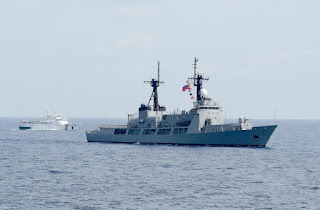South China Sea Dispute
Source: Google Images
By Naveed Qazi | Editor, Globe Upfront
By Naveed Qazi | Editor, Globe Upfront
With over $5 trillion of trade passing through the South China Sea, the strategic importance of this sea route continues to dominate.
Any political volatility would not only harm the countries in a territorial dispute but also larger trading economies in the area like Japan and South Korea.
In fact, it is a place where all global trade converges.
International media has mostly given attention to this trade route when any natural catastrophe has occurred.
In its quest for naval expansion and defence, Chinese State has already deployed more SSN nuclear submarines and SSBN ballistic missile submarines in the region, from Qingdao in the north, across the Yellow Sea from South Korea to Yulin, on Hainan Island in heart of South China Sea.
It seems that China wants to exert its authoritarian control over the sea in the recent past, even though it ratified Land of the Sea treaty in 1996.
Chinese State has even built elaborate signal stations, especially near Hainan. It also indicates that China is trying to pull the economic competition in the South China Sea towards itself with the help of its military, just like the US dominated the Caribbean in the 19th century.
In fact, it regards South China Sea as its own ‘continental shelf’ and cites historical records of Han’s Dynasty discovery and Ming/Qing dynasty control of the Paracel Island (also claimed by Taiwan and Vietnam) and Spratly Island (also claimed by Philippines, Taiwan, Vietnam and Malaysia) to back their claims, reflecting a Middle Kingdom mentality.
Even other countries that have been affected by the dispute in these troubled waters like Indonesia, Malaysia, and Singapore have increased their arms imports considerably. All these developments reflect a complex geo-politics structure.
Although, Chinese have pacified two hundred areas of dispute with Vietnam during the eight-year negotiation in the 1990s with demarcation work completed in 2008.
Vietnam’s GDP heavily relies on maritime trade and it claims a line two hundred miles straight out into the South China Sea, which Vietnamese call as the ‘East Sea’. This complies as per Conventions of the Law of the Sea, but it strangely overlaps with maritime areas claimed by China, Malaysia and Cambodia and Thailand in the adjacent Gulf of Thailand.
Chinese even claim that they have settled the maritime dispute with Vietnam in the Gulf of Tonkin (where northern Vietnamese coastline is blocked by open sea by China’s Hainan Island), by dividing the energy-rich gulf into half, although the mouth of the gulf still needs to be demarcated. But, logically, this gulf still remains a disputed area.
As the United States guards all the sea lines of communication necessary for international trade, many analysts, opposing Chinese dominance, believe that, the United States, with its sturdy air and naval power, can play a role of a balancing power in the South China Sea. Importantly, it can likely limit China to its maps.
At the present, the Philippines dominate the eastern edge of South China Sea; Vietnam dominates the western edge, while as the Chinese dominate the northern edge.
According to the scholar, Clive Schofield, Vietnam is a ‘principal protagonist’ in the South China Sea. He believes that Indonesia already has a well-defined foreign policy on the issue of South China Sea, whereas Malaysia prefers to be low key politically. Although, he also notes that the Philippines still has a few cards to play politically and ascertains that Brunei has already solved the problem with China.
The Pratas Island, controlled by Taiwan, has been declared as their national park. In history, Taiwanese controlled the island for harvesting abundant fish stocks. Taiwanese coastal guards still expel Chinese and Vietnamese fishing boats. Currently, Taiwan faces a threat of ‘Finlandisation’ by China, sooner or later.
The Philippines archipelago, that calls South China Sea as ‘West Philippine Sea’, has to address several internal problems. It imports all of its oil by sea. Any instability will lead the archipelago nation losing access to hydrocarbon reserves in areas of Spratly Island and Scarborough Shoal, as well as loss of existing fisheries.
In fact, the recent rift of China and Philippines in Scarborough Shoal in the spring of 2012, 120 miles west of Luzon, showed that the Chinese had intents of policing the waters with its dispatch of 20 lightly armed maritime vessels.
It seems that the Philippine archipelago has no choice but to ask for the patronage of United States because it is vulnerable to military attacks. It may also become ‘Finlandised’ by China. Historically, Washington sent aid to Philippines ($200 million every year) when Clark and Subic bases were still operational there.
China didn’t allow the Philippines to explore fifteen blocks because it fell with China’s ‘nine-dashed line’ (that encircles 90 percent of contested waters by China on the sea map). In fact, US foreign policy officials believe that China is looking for a ‘dry patch of land’ in the area for naval expansion.
Philippines has also contested this international dispute in the Court of Arbitration in the Hague, as Manila argues that this ‘nine-dashed line’ exceeds the limits of maritime entitlements under the UN Convention on the Law of the Sea (Unclos).




Comments
Post a Comment
Advice from the Editor: Please refrain from slander, defamation or any kind of libel in the comments section.